Business and Business Environment : UK
VerifiedAdded on 2021/01/01
|11
|2608
|433
AI Summary
Contribute Materials
Your contribution can guide someone’s learning journey. Share your
documents today.
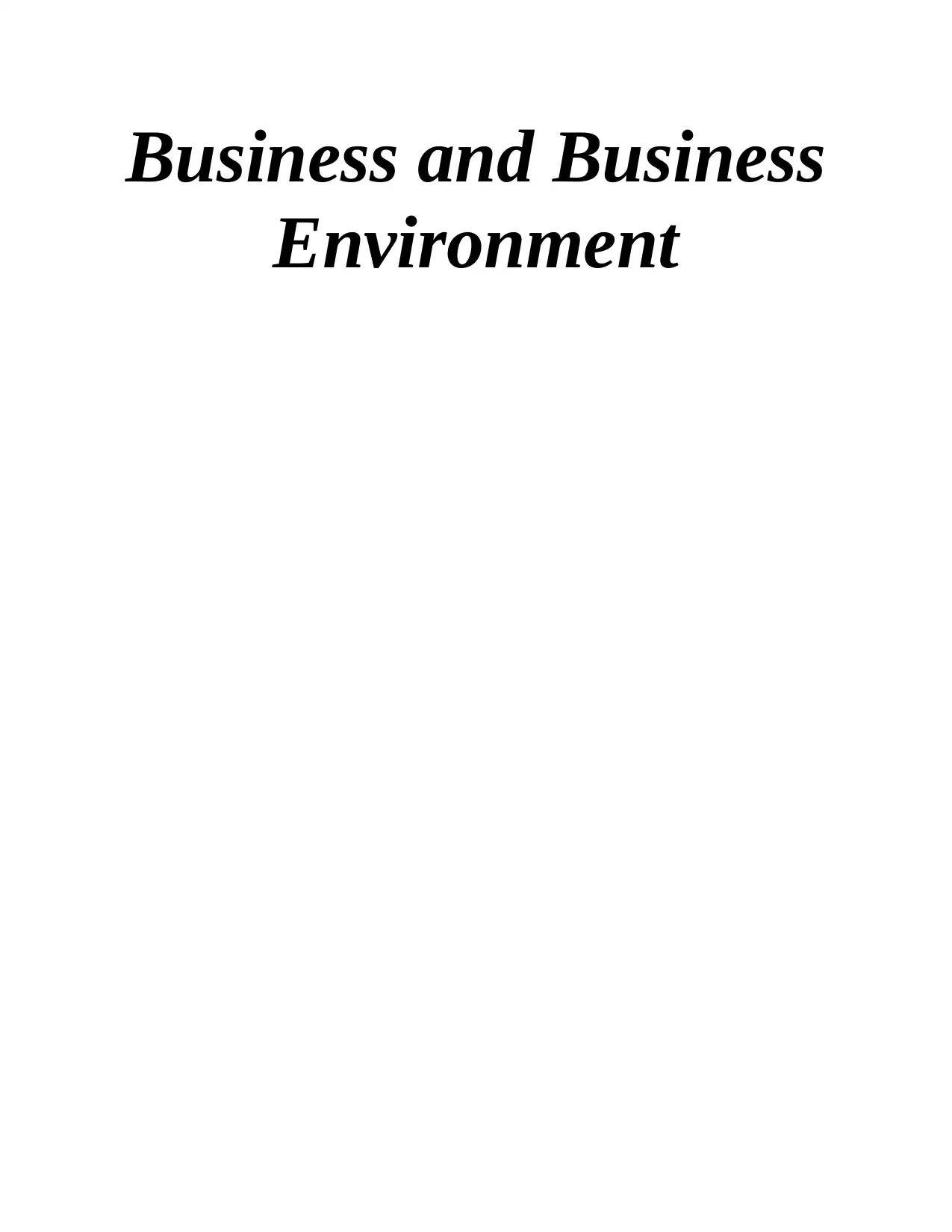
Business and Business
Environment
Environment
Secure Best Marks with AI Grader
Need help grading? Try our AI Grader for instant feedback on your assignments.

Table of Contents
INTRODUCTION...........................................................................................................................1
Activity 1.........................................................................................................................................1
P1 Different types and purposes of organisations; public, private and voluntary sectors and
legal structures........................................................................................................................1
P2 Size and scope of a range of different types of organisations...........................................3
P3 Relationship Between Organisational functions...............................................................6
CONCLUSION................................................................................................................................7
REFRENCES...................................................................................................................................8
INTRODUCTION...........................................................................................................................1
Activity 1.........................................................................................................................................1
P1 Different types and purposes of organisations; public, private and voluntary sectors and
legal structures........................................................................................................................1
P2 Size and scope of a range of different types of organisations...........................................3
P3 Relationship Between Organisational functions...............................................................6
CONCLUSION................................................................................................................................7
REFRENCES...................................................................................................................................8

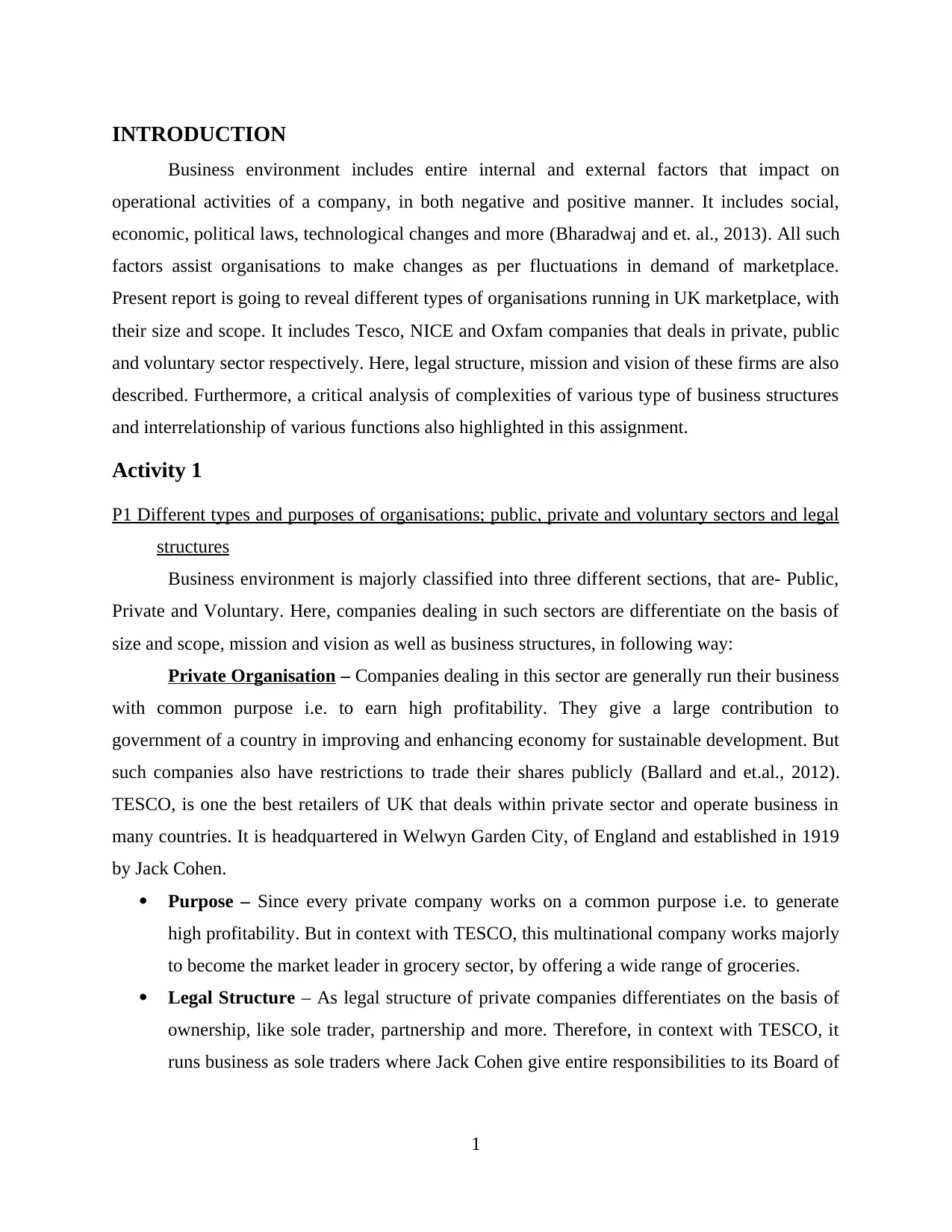
INTRODUCTION
Business environment includes entire internal and external factors that impact on
operational activities of a company, in both negative and positive manner. It includes social,
economic, political laws, technological changes and more (Bharadwaj and et. al., 2013). All such
factors assist organisations to make changes as per fluctuations in demand of marketplace.
Present report is going to reveal different types of organisations running in UK marketplace, with
their size and scope. It includes Tesco, NICE and Oxfam companies that deals in private, public
and voluntary sector respectively. Here, legal structure, mission and vision of these firms are also
described. Furthermore, a critical analysis of complexities of various type of business structures
and interrelationship of various functions also highlighted in this assignment.
Activity 1
P1 Different types and purposes of organisations; public, private and voluntary sectors and legal
structures
Business environment is majorly classified into three different sections, that are- Public,
Private and Voluntary. Here, companies dealing in such sectors are differentiate on the basis of
size and scope, mission and vision as well as business structures, in following way:
Private Organisation – Companies dealing in this sector are generally run their business
with common purpose i.e. to earn high profitability. They give a large contribution to
government of a country in improving and enhancing economy for sustainable development. But
such companies also have restrictions to trade their shares publicly (Ballard and et.al., 2012).
TESCO, is one the best retailers of UK that deals within private sector and operate business in
many countries. It is headquartered in Welwyn Garden City, of England and established in 1919
by Jack Cohen.
Purpose – Since every private company works on a common purpose i.e. to generate
high profitability. But in context with TESCO, this multinational company works majorly
to become the market leader in grocery sector, by offering a wide range of groceries.
Legal Structure – As legal structure of private companies differentiates on the basis of
ownership, like sole trader, partnership and more. Therefore, in context with TESCO, it
runs business as sole traders where Jack Cohen give entire responsibilities to its Board of
1
Business environment includes entire internal and external factors that impact on
operational activities of a company, in both negative and positive manner. It includes social,
economic, political laws, technological changes and more (Bharadwaj and et. al., 2013). All such
factors assist organisations to make changes as per fluctuations in demand of marketplace.
Present report is going to reveal different types of organisations running in UK marketplace, with
their size and scope. It includes Tesco, NICE and Oxfam companies that deals in private, public
and voluntary sector respectively. Here, legal structure, mission and vision of these firms are also
described. Furthermore, a critical analysis of complexities of various type of business structures
and interrelationship of various functions also highlighted in this assignment.
Activity 1
P1 Different types and purposes of organisations; public, private and voluntary sectors and legal
structures
Business environment is majorly classified into three different sections, that are- Public,
Private and Voluntary. Here, companies dealing in such sectors are differentiate on the basis of
size and scope, mission and vision as well as business structures, in following way:
Private Organisation – Companies dealing in this sector are generally run their business
with common purpose i.e. to earn high profitability. They give a large contribution to
government of a country in improving and enhancing economy for sustainable development. But
such companies also have restrictions to trade their shares publicly (Ballard and et.al., 2012).
TESCO, is one the best retailers of UK that deals within private sector and operate business in
many countries. It is headquartered in Welwyn Garden City, of England and established in 1919
by Jack Cohen.
Purpose – Since every private company works on a common purpose i.e. to generate
high profitability. But in context with TESCO, this multinational company works majorly
to become the market leader in grocery sector, by offering a wide range of groceries.
Legal Structure – As legal structure of private companies differentiates on the basis of
ownership, like sole trader, partnership and more. Therefore, in context with TESCO, it
runs business as sole traders where Jack Cohen give entire responsibilities to its Board of
1
Secure Best Marks with AI Grader
Need help grading? Try our AI Grader for instant feedback on your assignments.
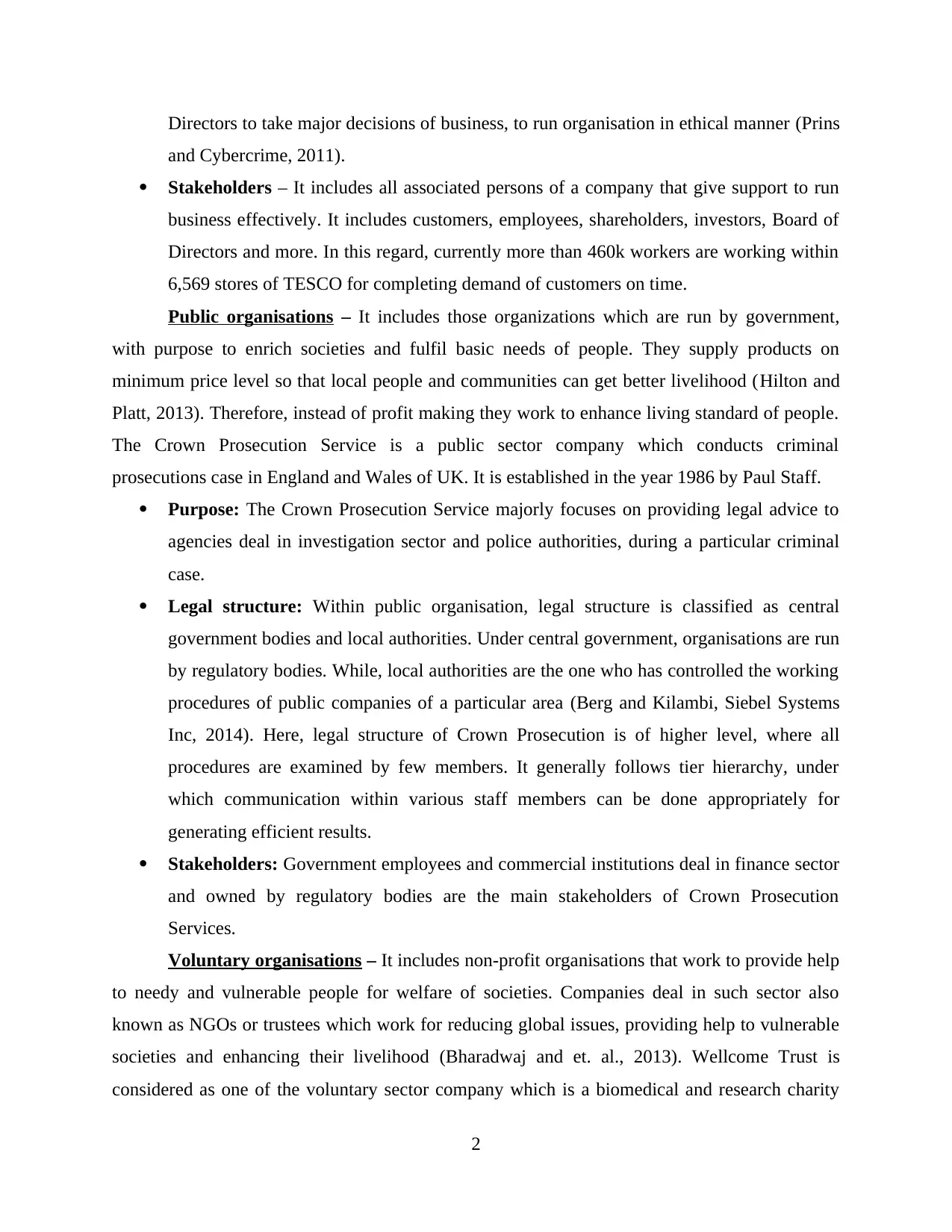
Directors to take major decisions of business, to run organisation in ethical manner (Prins
and Cybercrime, 2011).
Stakeholders – It includes all associated persons of a company that give support to run
business effectively. It includes customers, employees, shareholders, investors, Board of
Directors and more. In this regard, currently more than 460k workers are working within
6,569 stores of TESCO for completing demand of customers on time.
Public organisations – It includes those organizations which are run by government,
with purpose to enrich societies and fulfil basic needs of people. They supply products on
minimum price level so that local people and communities can get better livelihood (Hilton and
Platt, 2013). Therefore, instead of profit making they work to enhance living standard of people.
The Crown Prosecution Service is a public sector company which conducts criminal
prosecutions case in England and Wales of UK. It is established in the year 1986 by Paul Staff.
Purpose: The Crown Prosecution Service majorly focuses on providing legal advice to
agencies deal in investigation sector and police authorities, during a particular criminal
case.
Legal structure: Within public organisation, legal structure is classified as central
government bodies and local authorities. Under central government, organisations are run
by regulatory bodies. While, local authorities are the one who has controlled the working
procedures of public companies of a particular area (Berg and Kilambi, Siebel Systems
Inc, 2014). Here, legal structure of Crown Prosecution is of higher level, where all
procedures are examined by few members. It generally follows tier hierarchy, under
which communication within various staff members can be done appropriately for
generating efficient results.
Stakeholders: Government employees and commercial institutions deal in finance sector
and owned by regulatory bodies are the main stakeholders of Crown Prosecution
Services.
Voluntary organisations – It includes non-profit organisations that work to provide help
to needy and vulnerable people for welfare of societies. Companies deal in such sector also
known as NGOs or trustees which work for reducing global issues, providing help to vulnerable
societies and enhancing their livelihood (Bharadwaj and et. al., 2013). Wellcome Trust is
considered as one of the voluntary sector company which is a biomedical and research charity
2
and Cybercrime, 2011).
Stakeholders – It includes all associated persons of a company that give support to run
business effectively. It includes customers, employees, shareholders, investors, Board of
Directors and more. In this regard, currently more than 460k workers are working within
6,569 stores of TESCO for completing demand of customers on time.
Public organisations – It includes those organizations which are run by government,
with purpose to enrich societies and fulfil basic needs of people. They supply products on
minimum price level so that local people and communities can get better livelihood (Hilton and
Platt, 2013). Therefore, instead of profit making they work to enhance living standard of people.
The Crown Prosecution Service is a public sector company which conducts criminal
prosecutions case in England and Wales of UK. It is established in the year 1986 by Paul Staff.
Purpose: The Crown Prosecution Service majorly focuses on providing legal advice to
agencies deal in investigation sector and police authorities, during a particular criminal
case.
Legal structure: Within public organisation, legal structure is classified as central
government bodies and local authorities. Under central government, organisations are run
by regulatory bodies. While, local authorities are the one who has controlled the working
procedures of public companies of a particular area (Berg and Kilambi, Siebel Systems
Inc, 2014). Here, legal structure of Crown Prosecution is of higher level, where all
procedures are examined by few members. It generally follows tier hierarchy, under
which communication within various staff members can be done appropriately for
generating efficient results.
Stakeholders: Government employees and commercial institutions deal in finance sector
and owned by regulatory bodies are the main stakeholders of Crown Prosecution
Services.
Voluntary organisations – It includes non-profit organisations that work to provide help
to needy and vulnerable people for welfare of societies. Companies deal in such sector also
known as NGOs or trustees which work for reducing global issues, providing help to vulnerable
societies and enhancing their livelihood (Bharadwaj and et. al., 2013). Wellcome Trust is
considered as one of the voluntary sector company which is a biomedical and research charity
2
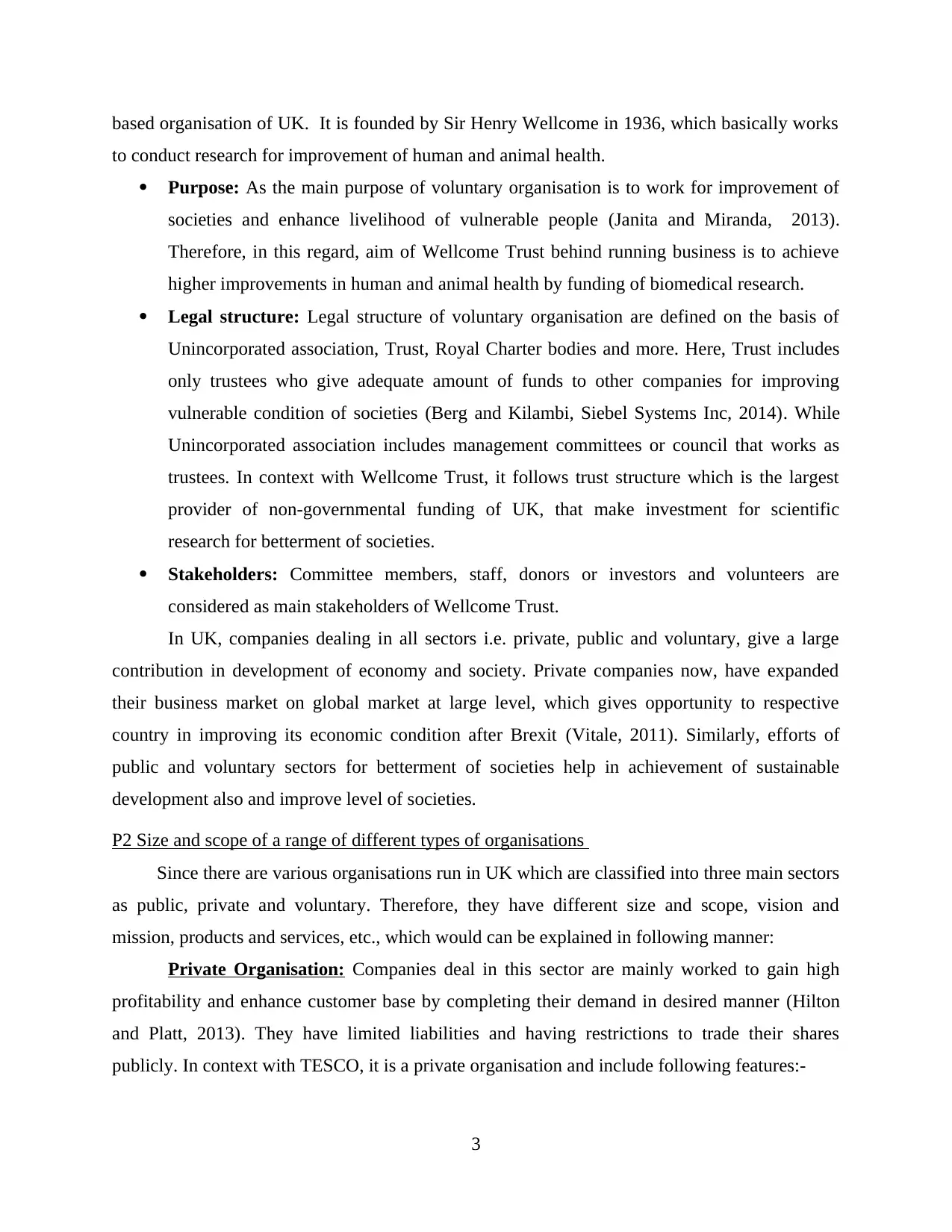
based organisation of UK. It is founded by Sir Henry Wellcome in 1936, which basically works
to conduct research for improvement of human and animal health.
Purpose: As the main purpose of voluntary organisation is to work for improvement of
societies and enhance livelihood of vulnerable people (Janita and Miranda, 2013).
Therefore, in this regard, aim of Wellcome Trust behind running business is to achieve
higher improvements in human and animal health by funding of biomedical research.
Legal structure: Legal structure of voluntary organisation are defined on the basis of
Unincorporated association, Trust, Royal Charter bodies and more. Here, Trust includes
only trustees who give adequate amount of funds to other companies for improving
vulnerable condition of societies (Berg and Kilambi, Siebel Systems Inc, 2014). While
Unincorporated association includes management committees or council that works as
trustees. In context with Wellcome Trust, it follows trust structure which is the largest
provider of non-governmental funding of UK, that make investment for scientific
research for betterment of societies.
Stakeholders: Committee members, staff, donors or investors and volunteers are
considered as main stakeholders of Wellcome Trust.
In UK, companies dealing in all sectors i.e. private, public and voluntary, give a large
contribution in development of economy and society. Private companies now, have expanded
their business market on global market at large level, which gives opportunity to respective
country in improving its economic condition after Brexit (Vitale, 2011). Similarly, efforts of
public and voluntary sectors for betterment of societies help in achievement of sustainable
development also and improve level of societies.
P2 Size and scope of a range of different types of organisations
Since there are various organisations run in UK which are classified into three main sectors
as public, private and voluntary. Therefore, they have different size and scope, vision and
mission, products and services, etc., which would can be explained in following manner:
Private Organisation: Companies deal in this sector are mainly worked to gain high
profitability and enhance customer base by completing their demand in desired manner (Hilton
and Platt, 2013). They have limited liabilities and having restrictions to trade their shares
publicly. In context with TESCO, it is a private organisation and include following features:-
3
to conduct research for improvement of human and animal health.
Purpose: As the main purpose of voluntary organisation is to work for improvement of
societies and enhance livelihood of vulnerable people (Janita and Miranda, 2013).
Therefore, in this regard, aim of Wellcome Trust behind running business is to achieve
higher improvements in human and animal health by funding of biomedical research.
Legal structure: Legal structure of voluntary organisation are defined on the basis of
Unincorporated association, Trust, Royal Charter bodies and more. Here, Trust includes
only trustees who give adequate amount of funds to other companies for improving
vulnerable condition of societies (Berg and Kilambi, Siebel Systems Inc, 2014). While
Unincorporated association includes management committees or council that works as
trustees. In context with Wellcome Trust, it follows trust structure which is the largest
provider of non-governmental funding of UK, that make investment for scientific
research for betterment of societies.
Stakeholders: Committee members, staff, donors or investors and volunteers are
considered as main stakeholders of Wellcome Trust.
In UK, companies dealing in all sectors i.e. private, public and voluntary, give a large
contribution in development of economy and society. Private companies now, have expanded
their business market on global market at large level, which gives opportunity to respective
country in improving its economic condition after Brexit (Vitale, 2011). Similarly, efforts of
public and voluntary sectors for betterment of societies help in achievement of sustainable
development also and improve level of societies.
P2 Size and scope of a range of different types of organisations
Since there are various organisations run in UK which are classified into three main sectors
as public, private and voluntary. Therefore, they have different size and scope, vision and
mission, products and services, etc., which would can be explained in following manner:
Private Organisation: Companies deal in this sector are mainly worked to gain high
profitability and enhance customer base by completing their demand in desired manner (Hilton
and Platt, 2013). They have limited liabilities and having restrictions to trade their shares
publicly. In context with TESCO, it is a private organisation and include following features:-
3
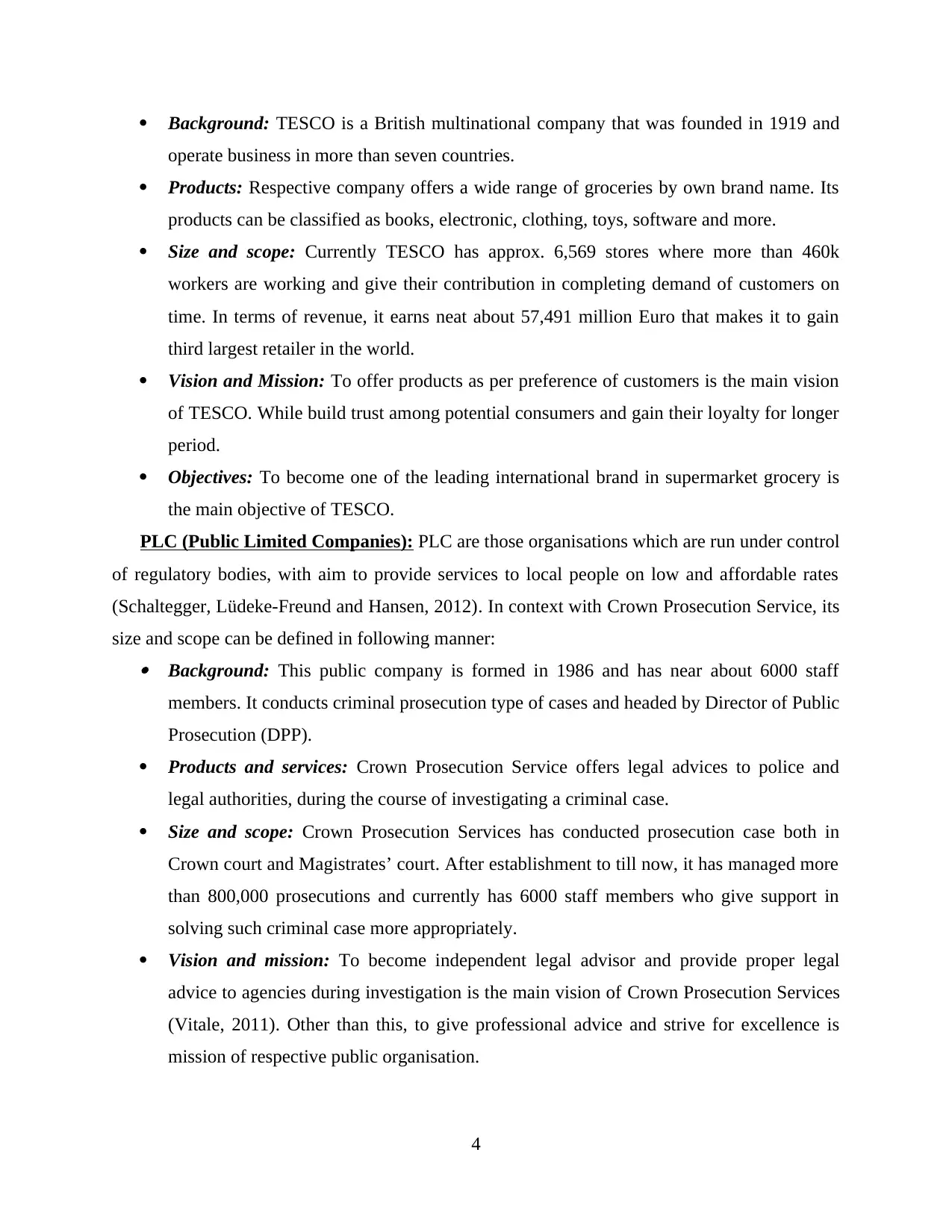
Background: TESCO is a British multinational company that was founded in 1919 and
operate business in more than seven countries.
Products: Respective company offers a wide range of groceries by own brand name. Its
products can be classified as books, electronic, clothing, toys, software and more.
Size and scope: Currently TESCO has approx. 6,569 stores where more than 460k
workers are working and give their contribution in completing demand of customers on
time. In terms of revenue, it earns neat about 57,491 million Euro that makes it to gain
third largest retailer in the world.
Vision and Mission: To offer products as per preference of customers is the main vision
of TESCO. While build trust among potential consumers and gain their loyalty for longer
period.
Objectives: To become one of the leading international brand in supermarket grocery is
the main objective of TESCO.
PLC (Public Limited Companies): PLC are those organisations which are run under control
of regulatory bodies, with aim to provide services to local people on low and affordable rates
(Schaltegger, Lüdeke-Freund and Hansen, 2012). In context with Crown Prosecution Service, its
size and scope can be defined in following manner: Background: This public company is formed in 1986 and has near about 6000 staff
members. It conducts criminal prosecution type of cases and headed by Director of Public
Prosecution (DPP).
Products and services: Crown Prosecution Service offers legal advices to police and
legal authorities, during the course of investigating a criminal case.
Size and scope: Crown Prosecution Services has conducted prosecution case both in
Crown court and Magistrates’ court. After establishment to till now, it has managed more
than 800,000 prosecutions and currently has 6000 staff members who give support in
solving such criminal case more appropriately.
Vision and mission: To become independent legal advisor and provide proper legal
advice to agencies during investigation is the main vision of Crown Prosecution Services
(Vitale, 2011). Other than this, to give professional advice and strive for excellence is
mission of respective public organisation.
4
operate business in more than seven countries.
Products: Respective company offers a wide range of groceries by own brand name. Its
products can be classified as books, electronic, clothing, toys, software and more.
Size and scope: Currently TESCO has approx. 6,569 stores where more than 460k
workers are working and give their contribution in completing demand of customers on
time. In terms of revenue, it earns neat about 57,491 million Euro that makes it to gain
third largest retailer in the world.
Vision and Mission: To offer products as per preference of customers is the main vision
of TESCO. While build trust among potential consumers and gain their loyalty for longer
period.
Objectives: To become one of the leading international brand in supermarket grocery is
the main objective of TESCO.
PLC (Public Limited Companies): PLC are those organisations which are run under control
of regulatory bodies, with aim to provide services to local people on low and affordable rates
(Schaltegger, Lüdeke-Freund and Hansen, 2012). In context with Crown Prosecution Service, its
size and scope can be defined in following manner: Background: This public company is formed in 1986 and has near about 6000 staff
members. It conducts criminal prosecution type of cases and headed by Director of Public
Prosecution (DPP).
Products and services: Crown Prosecution Service offers legal advices to police and
legal authorities, during the course of investigating a criminal case.
Size and scope: Crown Prosecution Services has conducted prosecution case both in
Crown court and Magistrates’ court. After establishment to till now, it has managed more
than 800,000 prosecutions and currently has 6000 staff members who give support in
solving such criminal case more appropriately.
Vision and mission: To become independent legal advisor and provide proper legal
advice to agencies during investigation is the main vision of Crown Prosecution Services
(Vitale, 2011). Other than this, to give professional advice and strive for excellence is
mission of respective public organisation.
4
Paraphrase This Document
Need a fresh take? Get an instant paraphrase of this document with our AI Paraphraser

Objectives: Crown Prosecution Services wants to become one of the finest legal advisor
and offer effective legal advice to agencies that handle criminal cases.
Voluntary sector- It includes those companies that seek out to provide services for welfare
of people by organising better education and job opportunities. Welcome Trust is one of the
trustee that provide funds to other companies who work for improvement of people an animal
health.
Background: Wellcome Trust is a biomedical research trustee that establishes in 1936
and considers as largest provider of funding for improvement of societies.
Vision and mission- The vision of this company is to accomplish objective related to
extra improvement in health of living beings (Janita and Miranda, 2013). It has
endowment of 25.9 billion Euro that makes it the third largest charitable trust within UK.
In this regard, to do work in the biomedical research for welfare of humanities has
become main mission of Wellcome Trust.
5
and offer effective legal advice to agencies that handle criminal cases.
Voluntary sector- It includes those companies that seek out to provide services for welfare
of people by organising better education and job opportunities. Welcome Trust is one of the
trustee that provide funds to other companies who work for improvement of people an animal
health.
Background: Wellcome Trust is a biomedical research trustee that establishes in 1936
and considers as largest provider of funding for improvement of societies.
Vision and mission- The vision of this company is to accomplish objective related to
extra improvement in health of living beings (Janita and Miranda, 2013). It has
endowment of 25.9 billion Euro that makes it the third largest charitable trust within UK.
In this regard, to do work in the biomedical research for welfare of humanities has
become main mission of Wellcome Trust.
5
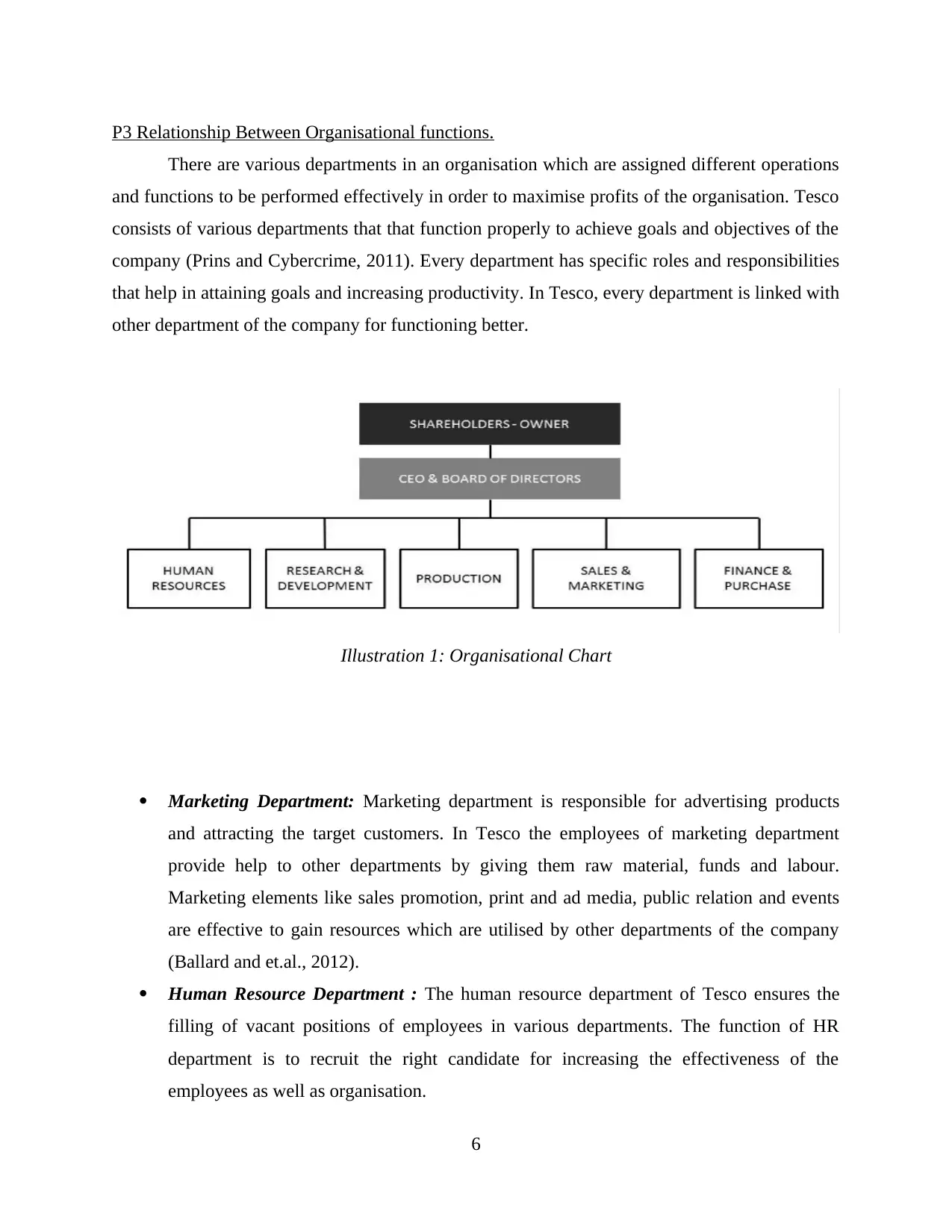
P3 Relationship Between Organisational functions.
There are various departments in an organisation which are assigned different operations
and functions to be performed effectively in order to maximise profits of the organisation. Tesco
consists of various departments that that function properly to achieve goals and objectives of the
company (Prins and Cybercrime, 2011). Every department has specific roles and responsibilities
that help in attaining goals and increasing productivity. In Tesco, every department is linked with
other department of the company for functioning better.
Marketing Department: Marketing department is responsible for advertising products
and attracting the target customers. In Tesco the employees of marketing department
provide help to other departments by giving them raw material, funds and labour.
Marketing elements like sales promotion, print and ad media, public relation and events
are effective to gain resources which are utilised by other departments of the company
(Ballard and et.al., 2012).
Human Resource Department : The human resource department of Tesco ensures the
filling of vacant positions of employees in various departments. The function of HR
department is to recruit the right candidate for increasing the effectiveness of the
employees as well as organisation.
6
Illustration 1: Organisational Chart
There are various departments in an organisation which are assigned different operations
and functions to be performed effectively in order to maximise profits of the organisation. Tesco
consists of various departments that that function properly to achieve goals and objectives of the
company (Prins and Cybercrime, 2011). Every department has specific roles and responsibilities
that help in attaining goals and increasing productivity. In Tesco, every department is linked with
other department of the company for functioning better.
Marketing Department: Marketing department is responsible for advertising products
and attracting the target customers. In Tesco the employees of marketing department
provide help to other departments by giving them raw material, funds and labour.
Marketing elements like sales promotion, print and ad media, public relation and events
are effective to gain resources which are utilised by other departments of the company
(Ballard and et.al., 2012).
Human Resource Department : The human resource department of Tesco ensures the
filling of vacant positions of employees in various departments. The function of HR
department is to recruit the right candidate for increasing the effectiveness of the
employees as well as organisation.
6
Illustration 1: Organisational Chart
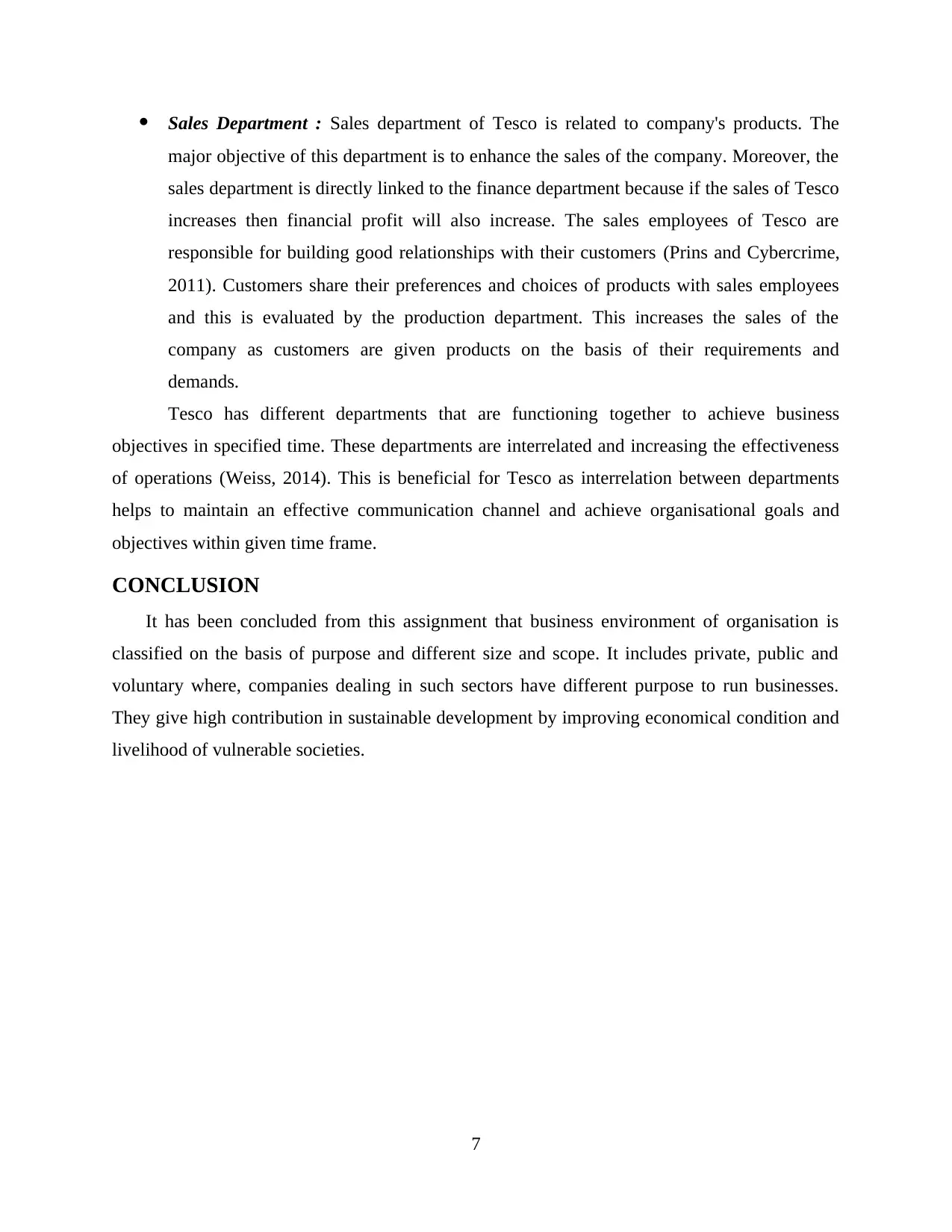
Sales Department : Sales department of Tesco is related to company's products. The
major objective of this department is to enhance the sales of the company. Moreover, the
sales department is directly linked to the finance department because if the sales of Tesco
increases then financial profit will also increase. The sales employees of Tesco are
responsible for building good relationships with their customers (Prins and Cybercrime,
2011). Customers share their preferences and choices of products with sales employees
and this is evaluated by the production department. This increases the sales of the
company as customers are given products on the basis of their requirements and
demands.
Tesco has different departments that are functioning together to achieve business
objectives in specified time. These departments are interrelated and increasing the effectiveness
of operations (Weiss, 2014). This is beneficial for Tesco as interrelation between departments
helps to maintain an effective communication channel and achieve organisational goals and
objectives within given time frame.
CONCLUSION
It has been concluded from this assignment that business environment of organisation is
classified on the basis of purpose and different size and scope. It includes private, public and
voluntary where, companies dealing in such sectors have different purpose to run businesses.
They give high contribution in sustainable development by improving economical condition and
livelihood of vulnerable societies.
7
major objective of this department is to enhance the sales of the company. Moreover, the
sales department is directly linked to the finance department because if the sales of Tesco
increases then financial profit will also increase. The sales employees of Tesco are
responsible for building good relationships with their customers (Prins and Cybercrime,
2011). Customers share their preferences and choices of products with sales employees
and this is evaluated by the production department. This increases the sales of the
company as customers are given products on the basis of their requirements and
demands.
Tesco has different departments that are functioning together to achieve business
objectives in specified time. These departments are interrelated and increasing the effectiveness
of operations (Weiss, 2014). This is beneficial for Tesco as interrelation between departments
helps to maintain an effective communication channel and achieve organisational goals and
objectives within given time frame.
CONCLUSION
It has been concluded from this assignment that business environment of organisation is
classified on the basis of purpose and different size and scope. It includes private, public and
voluntary where, companies dealing in such sectors have different purpose to run businesses.
They give high contribution in sustainable development by improving economical condition and
livelihood of vulnerable societies.
7
Secure Best Marks with AI Grader
Need help grading? Try our AI Grader for instant feedback on your assignments.
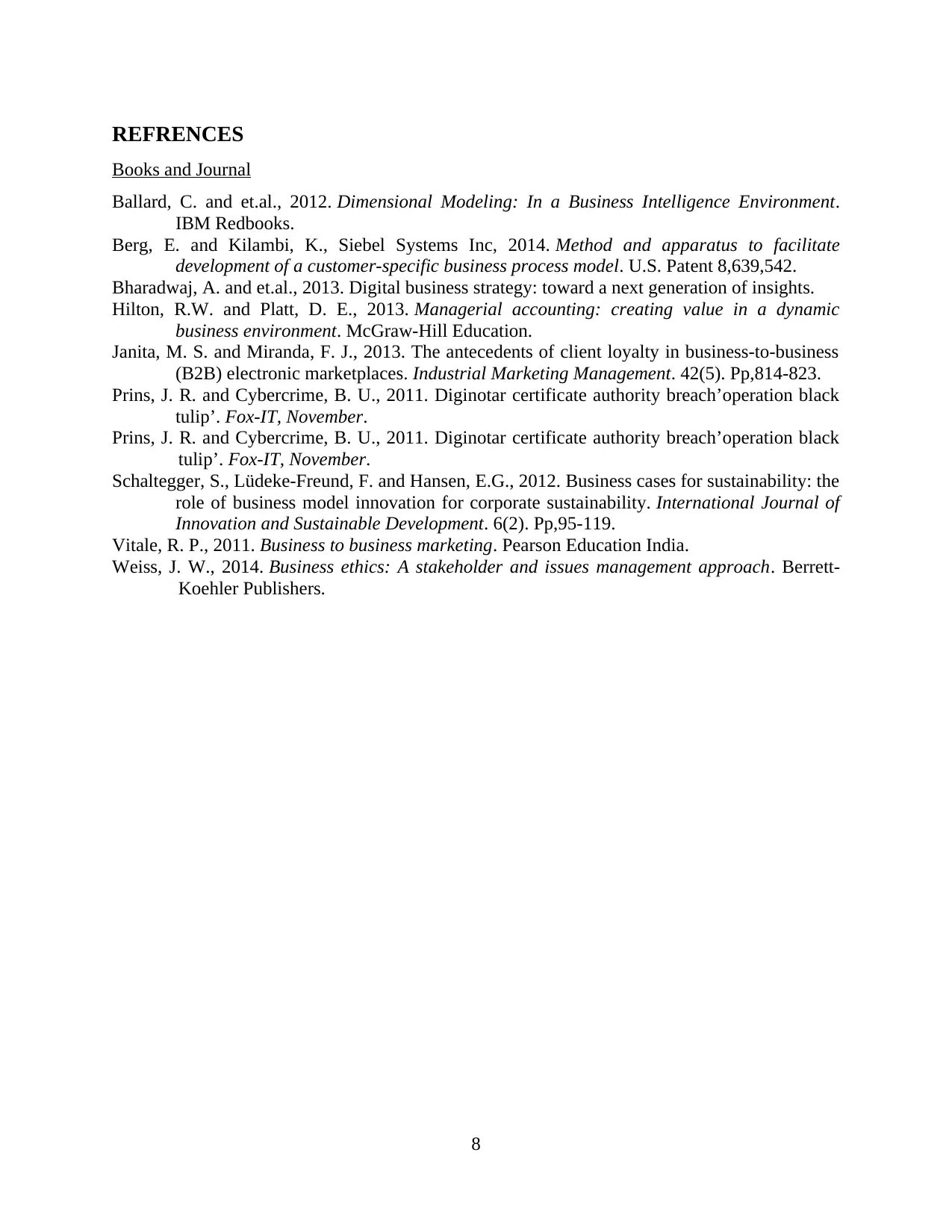
REFRENCES
Books and Journal
Ballard, C. and et.al., 2012. Dimensional Modeling: In a Business Intelligence Environment.
IBM Redbooks.
Berg, E. and Kilambi, K., Siebel Systems Inc, 2014. Method and apparatus to facilitate
development of a customer-specific business process model. U.S. Patent 8,639,542.
Bharadwaj, A. and et.al., 2013. Digital business strategy: toward a next generation of insights.
Hilton, R.W. and Platt, D. E., 2013. Managerial accounting: creating value in a dynamic
business environment. McGraw-Hill Education.
Janita, M. S. and Miranda, F. J., 2013. The antecedents of client loyalty in business-to-business
(B2B) electronic marketplaces. Industrial Marketing Management. 42(5). Pp,814-823.
Prins, J. R. and Cybercrime, B. U., 2011. Diginotar certificate authority breach’operation black
tulip’. Fox-IT, November.
Prins, J. R. and Cybercrime, B. U., 2011. Diginotar certificate authority breach’operation black
tulip’. Fox-IT, November.
Schaltegger, S., Lüdeke-Freund, F. and Hansen, E.G., 2012. Business cases for sustainability: the
role of business model innovation for corporate sustainability. International Journal of
Innovation and Sustainable Development. 6(2). Pp,95-119.
Vitale, R. P., 2011. Business to business marketing. Pearson Education India.
Weiss, J. W., 2014. Business ethics: A stakeholder and issues management approach. Berrett-
Koehler Publishers.
8
Books and Journal
Ballard, C. and et.al., 2012. Dimensional Modeling: In a Business Intelligence Environment.
IBM Redbooks.
Berg, E. and Kilambi, K., Siebel Systems Inc, 2014. Method and apparatus to facilitate
development of a customer-specific business process model. U.S. Patent 8,639,542.
Bharadwaj, A. and et.al., 2013. Digital business strategy: toward a next generation of insights.
Hilton, R.W. and Platt, D. E., 2013. Managerial accounting: creating value in a dynamic
business environment. McGraw-Hill Education.
Janita, M. S. and Miranda, F. J., 2013. The antecedents of client loyalty in business-to-business
(B2B) electronic marketplaces. Industrial Marketing Management. 42(5). Pp,814-823.
Prins, J. R. and Cybercrime, B. U., 2011. Diginotar certificate authority breach’operation black
tulip’. Fox-IT, November.
Prins, J. R. and Cybercrime, B. U., 2011. Diginotar certificate authority breach’operation black
tulip’. Fox-IT, November.
Schaltegger, S., Lüdeke-Freund, F. and Hansen, E.G., 2012. Business cases for sustainability: the
role of business model innovation for corporate sustainability. International Journal of
Innovation and Sustainable Development. 6(2). Pp,95-119.
Vitale, R. P., 2011. Business to business marketing. Pearson Education India.
Weiss, J. W., 2014. Business ethics: A stakeholder and issues management approach. Berrett-
Koehler Publishers.
8
1 out of 11
Related Documents
Your All-in-One AI-Powered Toolkit for Academic Success.
+13062052269
info@desklib.com
Available 24*7 on WhatsApp / Email
![[object Object]](/_next/static/media/star-bottom.7253800d.svg)
Unlock your academic potential
© 2024 | Zucol Services PVT LTD | All rights reserved.





